Since Deb and I left Virginia in 2017 we have traveled 27,202 miles, traveled in 36 States and visited over 60 locations managed by the National Parks System, not to mention the 20 or 30 National Forests we meandered through. We have revisited some of these majestic places and some we have simply crossed off our bucket list. One of the places that has captured our free spirit and sense of adventurism is New Mexico.

New Mexico was our last stop on 2019’s whirlwind tour of the USA. After traveling coast-to-coast, seeing family in Texas, Virginia, Pennsylvania, Ohio, Iowa, Oregon and Colorado, we just can’t get enough of New Mexico’s “Enchanted Evenings”.
We departed Colorado Springs and headed south on I-25. We breezed through Pueblo, Colorado City and Trinidad then crossed the New Mexico state line. After a fuel & puppy pitstop near Raton, we exited on US HWY 64 and headed west to Cimarron Canyon and Eagle Nest Lake State Park for a few days to enjoy the local scenery and do some fly fishing on Cimarron Creek.
Eagle Nest Lake State Park has beautiful Lakefront campsites. This particular campground did not have hook ups or a dump station but like in the real estate world, sometimes it’s just location, location, location!
This area is also a perfect place for daytrips to the north and south. The first stop on this day trip was to the small town of Angelfire, which is a popular winter resort destination for skiing and snowmobiling. We then continued to follow State HWY 434 to Coyote Creek State Park for a break to walk the puppies and see if this was a viable campground for the Black Pearl. Unfortunately, not suitable for a 40 “Super C”.
This scenic way also provided some excellent photo ops for old abandons, we passed through Williams Canyon and found a beautiful town chapel in Guadalupita, then continued our journey towards Mora.
Mora, New Mexico is located about halfway between Las Vegas, and Taos, NM on Highway 518, at an altitude of 7,180 feet. To our surprise it had three significant landmarks, the St Vrain Mill, the Cleveland Roller Mill and Teresa’s Tamales. So bizarre to find grist mills in the middle of nowhere, New Mexico and the roadside discovery of Teresa’s Tamales was so delicious and tasty that we looked for a reason to come back this way.
We continued up State HWY 518 and meandered through the hillsides and valleys, followed the Rio Pueblo and Agua Piedra Creek and then through the mountains to Taos and back on US HWY 64 to Eagle Nest Lake.
During our stay at Eagle Nest Lake, we also took the Enchanted Circle Byway which encompassed brief stops for scenic attractions along the route through Red River, Questa, Taos and back to Eagle Nest SP. We even managed to do a little fly fishing on the Red River along the way. Total distance about 85 miles, depending on side roads, length of time depending on how many places you want to stop to take photos, go fishing, see wildlife or walk the puppies in the creeks!
Our length of stay at Eagle Nest was shortened when we found out our old man doxie “Wrigley” had altitude sickness. Fortunately, we found a nearby Vet Clinic open on a Saturday, then quickly decided to break camp and head for our next destination, which was 1500 feet lower at Taos, New Mexico.
Taos is a beautiful area, an artisan epicenter, the mountain views are spectacular, the home of the San Francisco de Asis Mission and another excellent location for daytrips. Of course, we made a few!
One day we ventured south, down to Fort Union where we discovered some beautiful missions on our way and an unmarked gristmill which was a pleasant surprise and checked out some state parks for possible stays in the future.
The Fort Union National Monument is a unit of the National Park Service. It was founded in 1954. The site preserves the second of three forts constructed on the site in 1851, as well as the ruins of the third. A network of ruts from the Mountain and Cimarron Branches of the old Santa Fe Trail are visible. The fort served as the headquarters of the 8th Cavalry in the early 1870s and as the headquarters of the 9th Cavalry in the late 1870s during the Apache Wars.
The other adventure was north, back up into Colorado to see the Great Sand Dunes National Park and Preserve which protects the tallest dunes in North America. New Mexico State Hwy 522 heads north out of Taos and becomes Colorado Hwy 159 when you cross the state line. Enroute to our destination we passed by several amazing abandoned buildings, including an old gas station and a medical center.
In all the planning and plotting we do for our travels; this one was off our radar and a pleasant surprise. We discovered the Shrine of the Stations of the Cross. The Shrine is located on a mesa in the center of San Luis, Colorado’s oldest town. The Shrine is formally known as “la Mesa de la Piedad y de la Misericordia” (Hill of Piety and Mercy).
We had lunch in Fort Garland, took US Hwy 160W and the Hwy 150 past Blanca Peak and Mount Lindsey, then off in the distance the Great Sand Dunes with Mounts Herard & Zwischen in the background.
Deb and I ventured out to the dunes on a very windy day and were ill prepared for the sandblast conditions! We made it to the first landmark of significant ridges which was about a mile out and could barely see the people that were at the top the 750 feet tall dunes. Sensational views as the sun and clouds cast shadows across the peaks and valleys of nature’s sandcastle.
Our trip back to Taos, took us through Alamosa where we walked the puppies at the city visitor center and strolled through a railroad boneyard that had passenger cars from a bygone era.
Southbound on US Hwy 285, we stopped in Antonito long enough to see Cano’s Castle. In a nutshell, Cano’s Castle is a set of four gleaming towers, built single-handedly by Donald “Cano” Espinoza, a Native American Vietnam vet. Built largely out of beer cans and other metal refuse, for Espinoza the castle serves as a thanks for having his life spared during the Vietnam war.
The other landmark in this small town is the Cumbres & Toltec Scenic Railroad Antonito Depot. This narrow-gauge National Historic Landmark takes you for a 64-mile day trip you’ll never forget. Their coal-fired steam engine carries you through steep mountain canyons, high desert, and lush meadows as you zig zag between the Colorado and New Mexico border. This adventure is still on our bucket list and one day we will take this excursion.
We have always enjoyed this part of New Mexico and I am confident that our future travels will once again bring us back to experience the scenic vistas, the Rio Grande and our adventures in and around Taos.
In our travels across America, Deb and I have stayed at many campgrounds. Some regard Corps of Engineers campgrounds (called “COE campgrounds”) as the best public camping areas in the country. Most of them are located in primitive areas. They are known for being well-maintained. Simple amenities like shower houses, restrooms, water hookups, picnic tables, and fire rings are available. Some even have full services.
Deb and I were looking forward to this year’s return to Riana Campground (COE) at Abiquiu Lake. Northwest across the lake in the distance you can see Georgia O’Keeffe’s Ghost Ranch, to the Southwest, the Cerro Pedernal (Black Mesa), a short drive to the Southeast the incredible Plaza Blanca. All locations that Georgia O’Keeffe made famous in her landscape artistry.
Our first trip was a drive out to the Benedictine Abbey of Christ in the Desert. A short distance from the campground up US Hwy 84 to FR 151 began the day’s adventure. Along the way, Deb and I took several two-tracks to see more of the “Land of Enchantment”. The Mesa de Los Viejos’ red rock and exposed cliffs and contrasting colors is quite a spectacle.. Then following the Rio Chama on a narrow winding dirt road makes for many majestic scenic views and photo ops.
The next day, with beautiful blue skies and perfect weather, we hopped on US Hwy 84 and were off to Tierra Amarilla to see the Santo Nino Church and the remnants of a once vibrant community.
We had hopes of getting close to Brazos Peak but discovered that many of the roads were private and gated.
So, we headed to El Vado State Park for a picnic lunch and plot the rest of our day. Although quite isolated, this park on the lake was beautiful and still a possibility for a return visit for the fly-fishing opportunities below the dam on the Rio Chama.
NM-112 crosses the El Vado dam and provides abundant guidance on what you are getting yourself into, should you decide to proceed. Seemed like an invitation for exciting afternoon of off roading!
Surrounded by beautiful scenery , we ventured through the Jicarilla Apache Reservation, then found a FR-313 that had oil well pumps galore, evergreens, cliffs and red rocks, a perfect recipe for an eventful drive. We drove past Horse Heaven Canyon, Canada Gurule, Canada Tanque, and Pasture Canyon.
Hard to understand people that have scenery like this in their backyard, then decide that it’s a perfect location to dump trash. Frustrating to see Mother Nature being so openly abused. Even more frustrating to say that it’s a common occurrence.
Eventually, the backroads did take us out of the oil fields to a paved road, NM 595, that connected to NM 96 and successfully returned us back to the campground at Abiquiu Lake.
The next few days we spent a lot of time at Ghost Ranch. First, we purchased tickets for the O’Keeffe Landscape Tour in which we toured Ghost Ranch’s landscape by motorbus and saw through our own eyes the scenes and locations of Georgia O’Keeffe’s paintings interwoven with stories of her fifty years at Ghost Ranch. To this day, they are still discovering locations and determining time of day & year based on blossoming flowers and shrubs, where she created these masterpieces. Karen, our guide was brilliant. Her knowledge of the ranch and the surrounding geological formations significantly contributed to a spectacular morning.
We also spent a few days at their campground to do some hiking. The trip up to Chimney Rock was unbelievable. Georgia O’Keeffe’s home was barely visible in the distance below. The trail switched back and forth until you were ultimately to the top of the mesa, and almost eye level with this magnificent natural feature. The hike back down was much quicker and easier. So glad we got an early morning start as it did warm up a bit by the time we got back to the campsite.
The stroll around the grounds at the Ranch was also VERY photo op friendly. Such an inspiring place that has been visited by many for so many years. Ghost Ranch, her home in Abiquiu and her gallery in Santa Fe should be on your bucket list if you plan to visit New Mexico.
Our last adventure in Abiquiu was a morning hike up a dry wash at Plaza Blanca. Peaceful and serene with colorful cliffs all around us that narrowed into a slot canyon until we could go no further. NOT a place to be in the rainy season as there was plenty of flash flooding evidence to see how high the debris fields were in the branches of trees and shrubs.
We spent a couple of days in Santa Fe, revisiting the shops and the marketplace downtown which is a perfect spot for people watching.
We also discovered an excellent place for lunch, Mampuku Ramen had an appetizer to die for called Shrimp Stuffed Green Chile Tempura. DAMN!!!
We then ventured out to Pecos National Historical Park. The Sangre de Cristo Mountains are not far from Santa Fe, and the remains of Indian pueblos reminded us of the ancient civilizations that struggled to exist in this harsh environment.
Our stay at Cochiti Lake campground was another (COE) which was located within the boundaries of the Pueblo de Cochiti Indian Reservation about halfway between Santa Fe and Albuquerque. Cochiti Dam is one of the ten largest earthfill dams in the US.
This area provided us one final launchpad to see the “wildside” of New Mexico. This all-day road trip covered a lot of beautiful territory. Initially we had to get back out on I-25 South to get down to Bernalillo to US Hwy 550, past the Zia Pueblo to San Ysidro where the adventure up to Jemez canyon begins. The San Ysidro city park was a perfect place to walk the “three amigos” and a photo op of the local vintage fire truck.
At the Pueblo of Jemez Welcome Center, Deb purchased a small seed pot from a Native American that was a Pueblo Jemez tribe member. Such exquisite craftsmanship. Red rock landscape here is also breathtaking.
Our first detour off NM 4 was to visit the Gilman Tunnels on NM 485. During the 1920s, the Santa Fe North Western Railroad decided to build a line through this area to provide access for logging and mining companies. But the Guadalupe Box Canyon stood in the way. The rock here was extremely hard and the gushing river complicated the project. Workers forged ahead with the plan, using dynamite to create the two railway tunnels. This railroad was primarily used for hauling timber down from the mountains. After timber operations ceased in the 1960s most of the company’s land was deeded to the Forest Service. The old train tracks were replaced with a road.
Seemed like a perfect place for a dog walk and to see what was behind the gated road. One day we WILL fulfill our destiny and see what’s on the “other side”.
We continued up on NM 4 past the Linda Vista Campground where we had a short stay in 2018, past Jemez Springs & Jemez Pueblo, then Soda Dam and a quick drive through Valles Caldera National Preserve. A spectacular volcanic eruption created this 13-mile wide circular depression about 1.25 million years ago.
A detour off the main road (FR36) took us along the Cochiti Mesa ridge which provided startling views of a fire ravaged area that was still recovering. Many homes were devoured several years ago. We spoke to a local gentleman that still lived up there. His home was one of the very few that survived the wind-swept firestorms. It never ceases to amaze me how resilient mother nature is to see this kind of regrowth in such a rugged and harsh terrain.
Our last stop of significance was at Bandelier National Monument. It protects over 33,000 acres of rugged but beautiful canyon and mesa country as well as evidence of a human presence going back over 11,000 years. Petroglyphs, dwellings carved into the soft rock cliffs, and standing masonry walls pay tribute to the early days of a culture that still survives in the surrounding communities. We stopped at the visitor center but having the dogs with us we knew we would have to save the hike for another visit.
The late afternoon skies were fast approaching as we drove through White Rock. The Overlook provided a lofty view of the Rio Grande, offered glimpses of Diablo & Mortandad Canyons and off in the distance, Ortiz Mountain and Montoso Peak. US Hwy 84 got us back down to Santa Fe, a short jaunt down I25 South to NM16 & 22 and B-O-O-M we were back at our campsite at Cochiti Lake.
We purposefully bypassed Albuquerque as the Balloon Fiesta was still in full swing and we were not interested in coping with the crowds and chaos that is associated with it. It is a spectacular event! Witnessing the morning balloon launch is supposed to be an experience of a lifetime. Many RV’ers roost there for the whole week and have nothing but great things to say about it. Just not our cup of tea, especially after being on the road since February.
Caballo Lake State Park was our LAST stop in New Mexico. We had intended to stay a few days and enjoy a visit to Hatch to replenish our salsa and chorizo cravings. But somewhere between Socorro and Truth or Consequences NM, we decided to shorten our stay. We quickly set up camp, took a drive to Hatch for our cravings and the next day we were off to Tucson for some much needed down time.
Thanks for following our adventures this year. We will be back again next year to share our travels. Be sure to bookmark our website at alwaysondafly.com.




















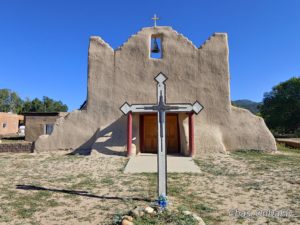







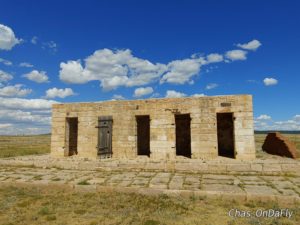














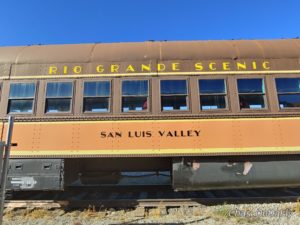







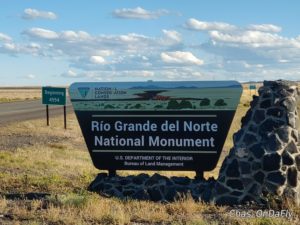




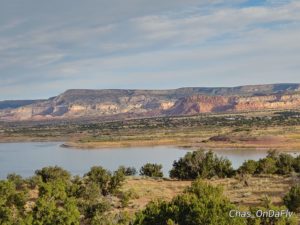
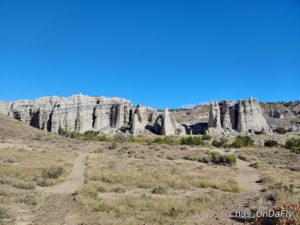



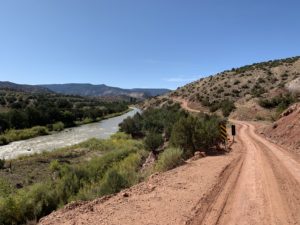












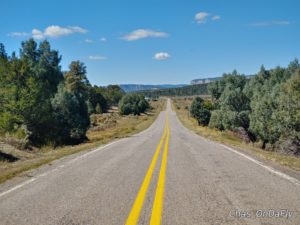













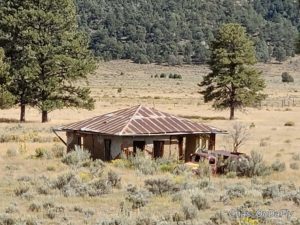






















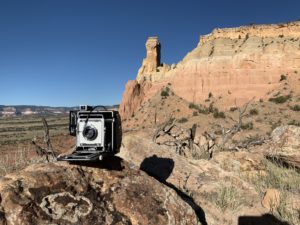


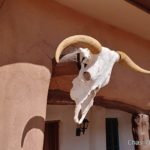























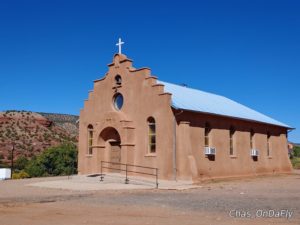










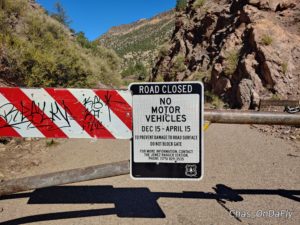









Leave a Reply